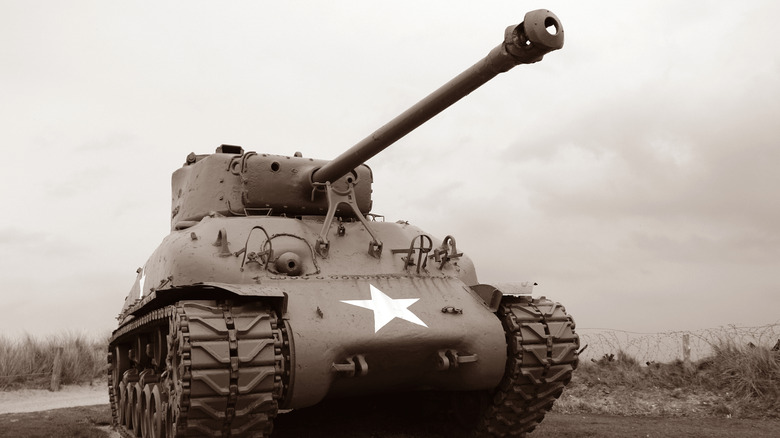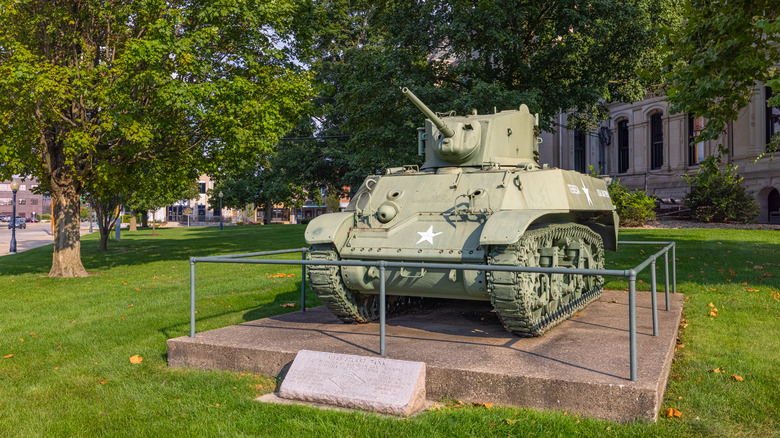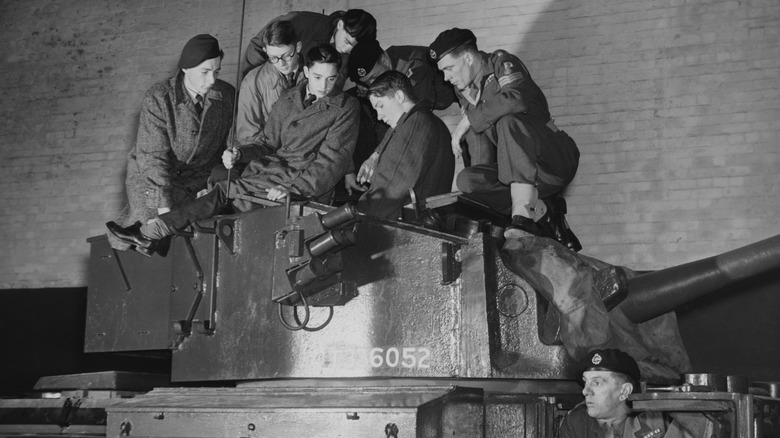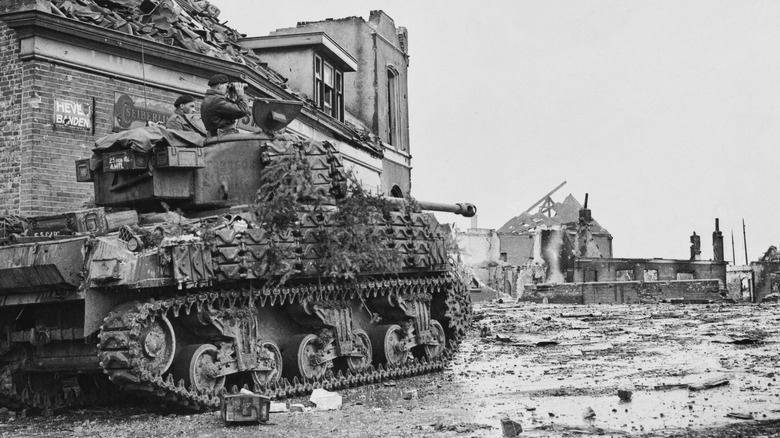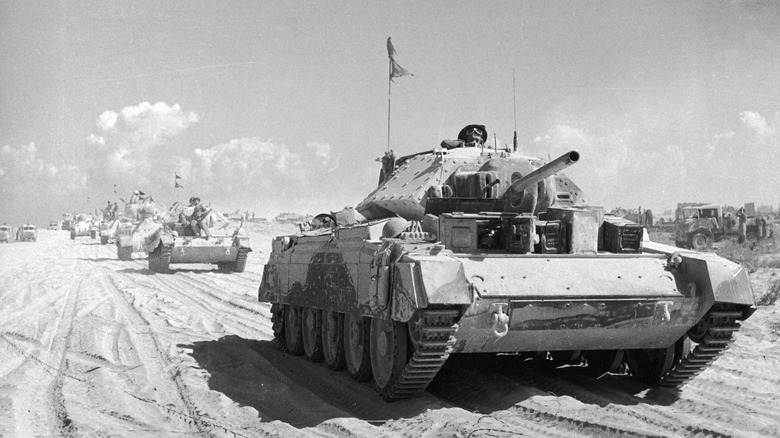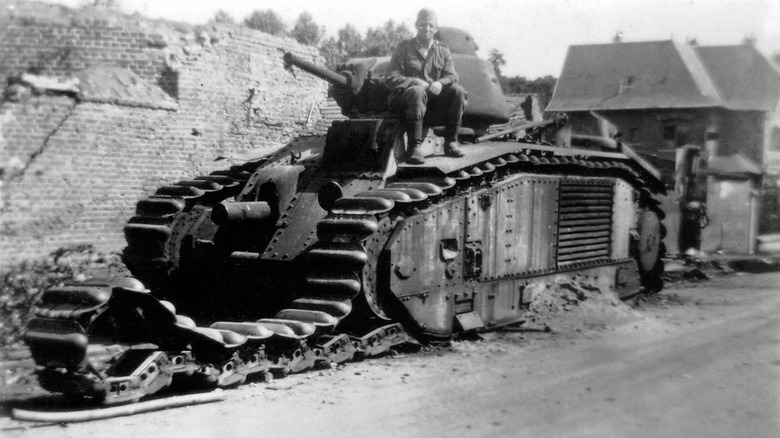The 5 Best Allied Tanks Of WWII
Long before the well-engineered M1 Abrams, tanks were used in warfare as far back as 1915 in the first half of WWI. By the time the Second World War commenced in 1939, they had evolved into a dominating force on the battlefield. They were central to all of the land campaigns during the war from North Africa to Russia and northern France all the way to Japan and into Germany in 1945. Able to drive over most terrain, these more than 30-ton behemoths evolved during the war on both sides of the conflict, creating new challenges for the opposing side that would try anything to stop them.
Both the Axis and Allies had legendary tanks. The Axis tanks were fearsome and had their strengths with heavy armor as they blitzed outwards from Germany, but tanks made by the Allied forces from Britain, France, and later the United States ultimately succeeded in tamping down Germany's advances. Some tanks were more versatile than others, and some were just plain devastating to opposing forces. These are the five best Allied tanks of WWII.
M3 Stuart
The American M3 Stuart tank was a favorite for British soldiers during WW2, even though it wasn't the most powerful tank available to the Allies. It even prompted British soldiers to nickname it "Honey" because of its speed and smooth maneuverability. It was lighter weight than other tanks and could zip across the battlefield at speeds of up to 36 miles per hour. It first came on the scene in July 1940 but wasn't used on the battlefield until November 1941, when British forces took it into combat in North Africa.
While the British liked the M3's handling, they considered it under-gunned, with a 37mm main gun that was no match for German tank armor. American forces had a similar experience a year later, again taking the M3 into action in North Africa, with one veteran later saying, "Popcorn balls thrown by Little Bo Peep would have been just as effective," as reported by The National WWII Museum. As a result, it was mainly used for reconnaissance and would bring up the rear in most operations.
The M3 Stuart would later go on to have success in the Pacific, where it failed in Europe and North Africa because its smaller footprint and light weight made it more well-suited for jungle combat than heavier tanks.
Comet Cruiser Tank
The Comet Cruiser tank was a latecomer to WWII, with the first prototype arriving in February of 1944, but it wouldn't make it into combat until September of that year. It was built as an improvement to Britain's Cromwell medium tank used in previous years and used the same chassis. But it added many improvements over the Cromwell, not the least of which was a powerful 77mm main gun. The British hoped this would be the tank that could handle any German tank it came across.
The 77mm gun fired a 17-pound projectile that could penetrate 109mm of armor thickness from as far as 1,500 feet away. It had improved overall armor protection than previous tanks and a new engine that could get the tank going up to 32 mph. It also featured two 7.92mm BESA tank machine guns for when infantry got close, with one mounted on the front and the other on the back.
The Comet was used to cross the Rhine River in the final push into Germany in 1945. It also went on to participate in the Korean War, which started in June 1950. It was eventually replaced in the 1960s with the much more technologically advanced Centurion Main Battle Tank.
M4 Sherman Firefly
The M4 Sherman Firefly was based on America's Sherman tank with added improvements. But the big difference was the addition of a more powerful 77mm gun whose ordinance was dubbed "the 17-pounder" that would lay waste to the other tanks on the battlefield. At the time, Brittain was sorely in need of a tank that could take on the German Panthers and Tigers, and the M4 Firefly would be up to the task.
The name Firefly originated on the battlefield because of the bright flames that would emit from the muzzle with every shot. It was so bright, in fact, that the gunner and commander would close their eyes upon firing because if they didn't, they would be blinded long enough that they would see it reach its target. The 77mm gun on the Firefly was the best tank gun in the Allies' arsenal until the Pershing heavy tank became available in 1945.
A man named William George Kennings Kilbourn was the engineer who figured out how to quickly convert Sherman tanks into Fireflies, and they would end up being some of the most-used tanks in the war.
Crusader Tank
The Crusader tank was one of the best tanks Britain had in the early part of WW2, but its flaws ultimately relegated it to reconnaissance missions as German tanks evolved. The Crusader was one of Britain's fastest tanks in WW2 and did extremely well on flat terrain, which made it a great option during the early campaign in North Africa.
It was designed to be faster than most infantry tanks, which also, unfortunately, meant it had lighter armor than its German counterparts. Likewise, its 40mm cannon was highly successful early on, but as German tanks started getting thicker and thicker armor, it lost its standing as one of the best tanks in the Allied war effort.
Once the North African campaign had been won, the Crusader fell out of favor because of its lower-powered cannon and light armor. It was replaced by the more powerful American Sherman and Grant tanks.
Char B1
The Char B1 was a French-built tank that was widely known in the early part of WW2 as one of the best tanks on the battlefield. It was slow and heavy but offered more firepower and better armor than the early German tanks. French soldiers could sit safely inside while early German Panzer tanks would watch as their low velocity 75mm shells wound bounce off the B1 hull. Meanwhile, the B1's 75mm Howitzer could blast away Panzers seemingly at will.
Despite being more powerful than German tanks at the beginning of WW2, the B1 had a lot of flaws. Its top speed was 17 miles per hour, while its counterparts could go around 25 miles per hour. With its weight and fuel consumption, it only had a range of 110 miles. The French army even added trailers for the tanks to have an extra supply of fuel handy, but it wouldn't last. Eventually, German air strikes and poor French war strategies led them to be invaded. With the low fuel supplies, many French soldiers abandoned their B1s undamaged.
Still, during the early part of WW2, the Char B1 was a juggernaut and would become one of the best tanks deployed in the war.
